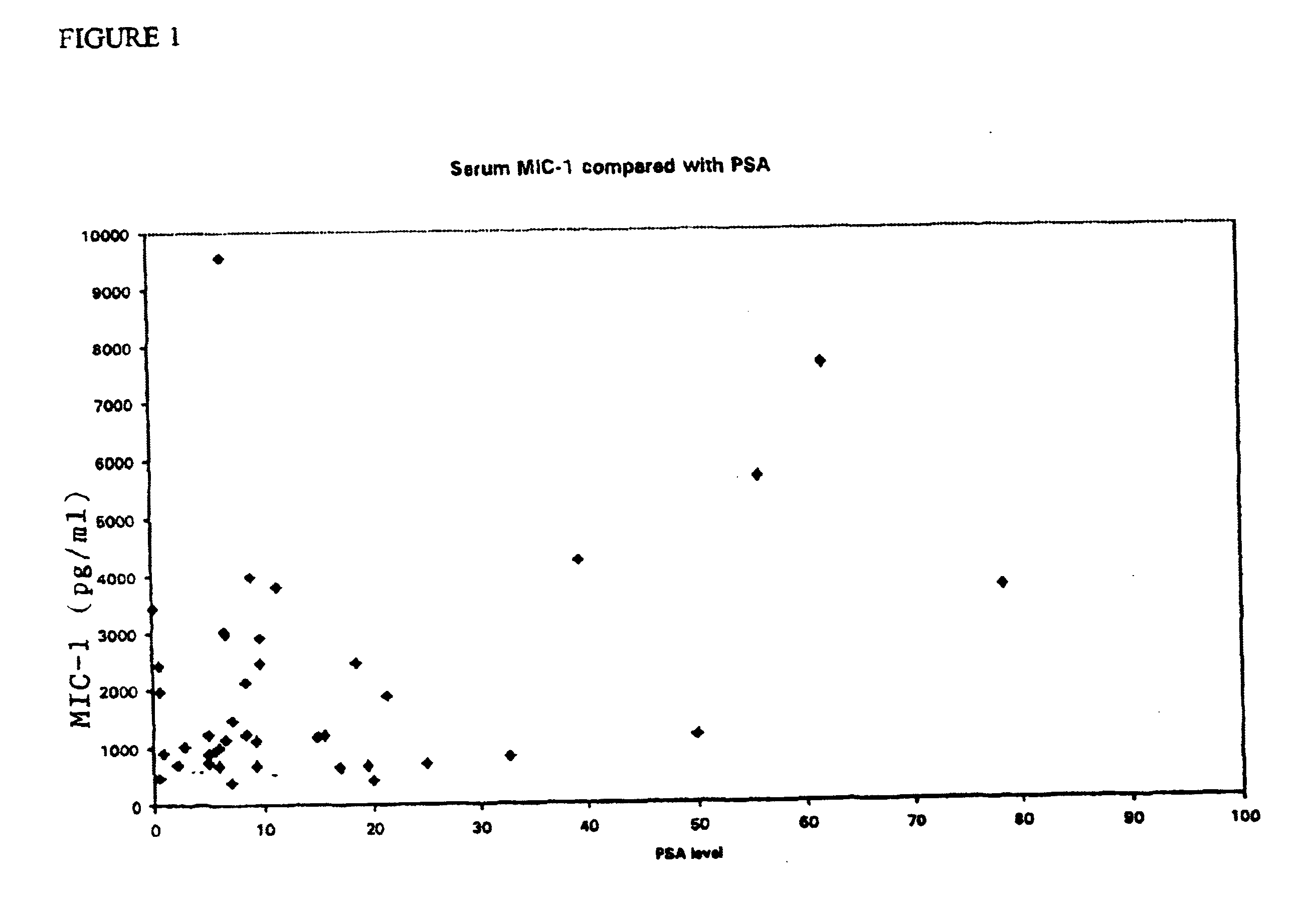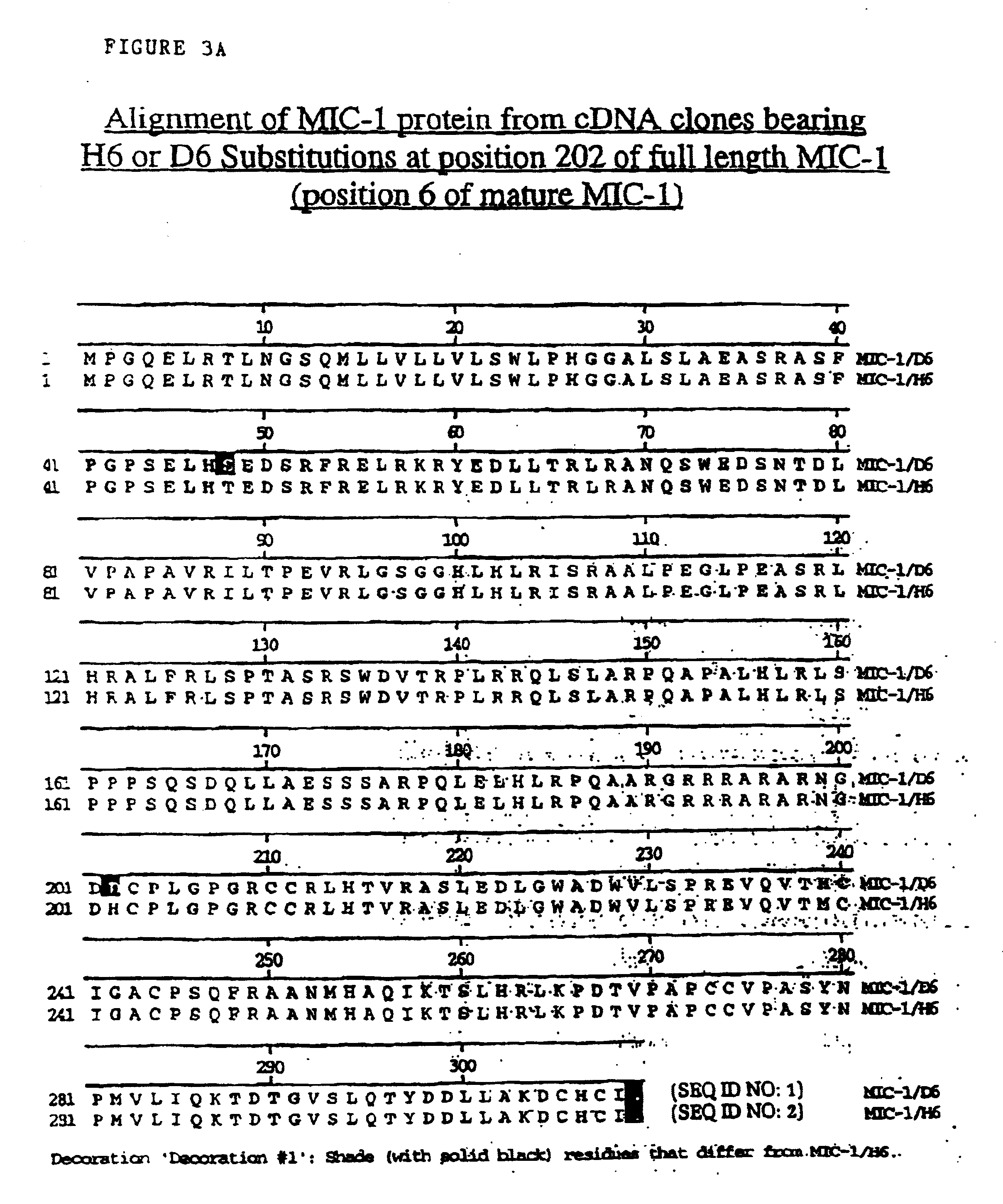Diagnostic assay and method of treatment involving macrophage inhibitory cytokine -1 (mic-1)
a macrophage inhibitor and assay technology, applied in the field of diagnostic assay and method of treatment involving macrophage inhibitory cytokine1 (mic1), can solve the problems of consequently increased risk of miscarriage and/or premature birth
- Summary
- Abstract
- Description
- Claims
- Application Information
AI Technical Summary
Benefits of technology
Problems solved by technology
Method used
Image
Examples
example 2
MIC-1 Variant Detection Detection and Genotyping By Immunoassay
[0127] In the process of cloning MIC-1 it was realised that there were at least two alleles of this TGF-.beta. superfamily cytokine. In subsequent investigation of human material it was confirmed that the 2 alleles were represented in the general community. These alleles differ by a point mutation yielding a change from histidine at position 6 of the amino acid sequence of mature normal or "wild type" MIC-1 (H6), to an aspartic acid at position 6 (D6). This represents a non-conservative substitution of a weakly basic, aromatic amino acid to a strongly acidic, acyclic amino acid.
[0128] Methods and Results:
[0129] Generation of Anti-MIC-1 Antibodies:
[0130] Anti-MIC-1 monoclonal antibody (MWb) secreting hybridomas were generated from mice immunised with recombinant human MIC-1 (rhMIC-1), which was produced in yeast (Pichia pastoris) in accordance with the method described in International patent publication No. WO 97 / 00958. ...
example 3
Ratiometric PCR RFLP Assay for Determination of MIC-1 Genotype
[0158] Restriction fragment length polymorphism (RFLP) assays have been a mainstay of DNA mutational analysis for many years. Some of these assays have been superseded by more sensitive, less labour intensive polymerase chain reaction (PCR) assays. In other, mutation detection, assays the two methods have been combined to detect different-DNA polymorphisms. In the case of MIC-1, the area of point mutation for the H6-D6 allele is approximately 90% GC rich. This makes it very difficult to use strategies such as competitive PCR to determine allelic, or genotypic differences. This necessitated the use of a RFLP analysis of PCR amplified DNA segments.
[0159] The RFLP assay depends on differences in DNA restriction enzyme sites conferred by differences in the DNA sequence. These sites are usually unique or give a distinct difference in the pattern of bands seen when restriction enzyme digests are separated, according to molecula...
example 4
ELISA Assays Performed With Samples From Rheumatoid Arthritis (RA) Patients
[0170] ELISA assays according to the following methods were performed on serum samples taken from an unselected population of 21 individuals with RA, and a further 9 individuals having very severe RA which had failed to respond to traditional therapies. The results are presented in Table 2 below.
[0171] Methods:
[0172] MIC-1 Sandwich ELISA:
[0173] A MIC-1 sandwich ELISA was established utilising the anti-MIC-1 mouse Mabs (13C4H3 and 26G6H6) for antigen capture and the labelled sheep polyclonal antibody (PAb 233-P) for detection. The optimum concentration of the antibodies was determined empirically then used for all subsequent studies. Ninety-six well Maxisorp ELISA plates were coated with anti MIC-1 MAb supernatant diluted 1:5 (final immunoglobin concentration was approximately 20 ng / ml) in coating buffer at 40.degree. C. for 24 hours. Plates were then washed three times with 300 .mu.l of wash buffer and non-sp...
PUM
| Property | Measurement | Unit |
|---|---|---|
| volume | aaaaa | aaaaa |
| concentration | aaaaa | aaaaa |
| concentration | aaaaa | aaaaa |
Abstract
Description
Claims
Application Information
 Login to View More
Login to View More - R&D
- Intellectual Property
- Life Sciences
- Materials
- Tech Scout
- Unparalleled Data Quality
- Higher Quality Content
- 60% Fewer Hallucinations
Browse by: Latest US Patents, China's latest patents, Technical Efficacy Thesaurus, Application Domain, Technology Topic, Popular Technical Reports.
© 2025 PatSnap. All rights reserved.Legal|Privacy policy|Modern Slavery Act Transparency Statement|Sitemap|About US| Contact US: help@patsnap.com



